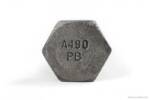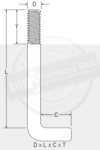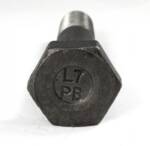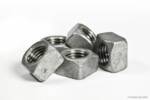Portland's FAQs
Portland Bolt measures round bend U-bolts based on the dimensions outlined in the Industrial Fastener Institute Standard IFI-136. The length (L) is measured from end of bolt to inside of the bend, while the width (C) is measured between the legs. Some companies will show the length to the bottom or centerline of the bend... Read more
The ASTM F3125 Grade A490 specification does not allow either hot-dip galvanizing (per ASTM F2329) or mechanical galvanizing (per ASTM B695) due to the risk of hydrogen embrittlement. The only coating currently allowed on A490 bolts is a zinc aluminum coating meeting ASTM F3393, which is itself a combination of three coating standards, F1136, F2833,... Read more

ASME B18.31.5 is, “The standard that establishes general requirements for parts classified as bent bolts.“ According to this specification, “The inside diameters or bend radii shall be as agreed between the buyer and manufacturer, as each dimension depends on material characteristics.” In essence, there is no standard guideline for the radius of the bend in... Read more

ASTM A320 possesses several fastener grades manufactured from either alloy or stainless steel and are intended for cold temperature applications. Both Grade L7 and L7M are manufactured from a quenched and tempered alloy steel. While the chemical requirements for both Grades L7 and L7M are identical, there are several differences that separate the two grades.... Read more

The organization that is responsible for addressing dimensional guidelines and tolerances for fasteners is the American Society of Mechanical Engineers (ASME). This organization was founded in 1880 and now has over 130,000 members in 151 countries. In addition to being a standards organization, ASME is also involved in research and development, training and professional development,... Read more

Most square nuts in the marketplace are made from low or medium carbon steel and are typically used with square head bolts. Their strength is not compatible with high strength bolts. These nuts are readily available in plain finish and hot-dip galvanized and are typically mass produced overseas. If you are looking for high strength... Read more

We run the nut onto the bolt until it stops, and we measure from end of inward face of the nut to end of bolt. This does not include any thread runout which can range from ½” long for ¾” diameter and 1-1/4” long for 2-1/2” diameter and larger.

The unthreaded portion of a headed bolt is called the grip. The length of all headed bolts (except countersunk head bolts) are measured from underneath the head to the end of the threads. The overall bolt length is made up of thread length plus grip length.
Unfortunately, Portland Bolt does not have any engineers on staff. For this reason and due to liability issues, we are unable to make recommendations with regard to quantity, size, configuration, or grades of fasteners for specific applications. By the time we get involved in manufacturing bolts for a construction project, an architect and engineer have... Read more
Yes Portland Bolt offers custom packaging. Many of our light rail customers have us fully assemble the OCS foundation bolts marked with the foundation type. This allows them to simply drop the fully assembled bolts into their location. This also frees up their people from the task of field assembling product they may not be... Read more
